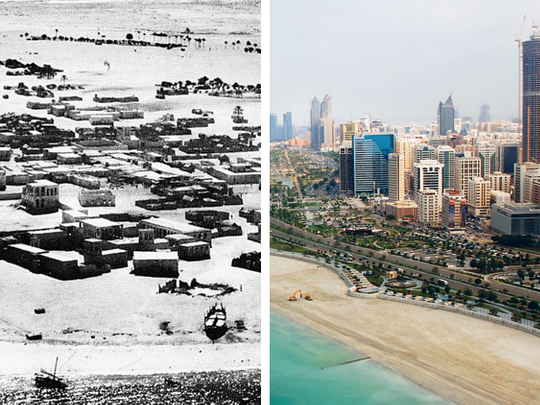
Dubai: A quick glance at an album of photos of the city of Abu Dhabi, taken prior to 1970, begins with black and white pictures showing stretches of dusty desert, but not much else. However, as you turn the pages, the images, archived in sequence, rapidly become more colourful, increasingly showing glittering details of the elegant infrastructures of the modern-day city.
In fact, you'd be astonished by the radical changes that have taken place in Abu Dhabi in what seem like the blink of an eye. And what is even more impressive is that these changes were meticulously planned by a strong and visionary leadership.
However it's the chapters, not of the album, but of history, that bear witness to the chain of events that the emirate has gone through.
Perhaps the most crucial ones date back to the 16th century, illustrating the influence of Portugal on the UAE. The mid 18th century saw Oman becoming an important power in the UAE. And shortly afterwards, the British took control of the Arabian Gulf.
Abu Dhabi was only formally claimed in the late of 18th century, specifically in 1793 according to the historical records by the Bani Yas tribe, whose origins can be traced to the region of the Liwa Oasis on the edge of the Empty Quarter desert.
The Bani Yas tribe took charge of the emirate in the 19th century when the economy was mainly dependent on fishing and pearl diving. There was also a great reliance on dates, palm trees and vegetables, which were collected from Al Ain city.
Prosperity
The prosperity, however, of pearl trading in the early 20th century did not last long and the collapse of the business led to a state of poverty throughout the Gulf region.
Abu Dhabi had no choice but to look for an alternative source of income. This led the ruler of Abu Dhabi to grant petroleum concessions in 1939. Then in 1952, the first oil site was explored and the result was a monumental turning point in Abu Dhabi's history.
The production of oil paved the way for a promising future for the capital.
But this massive enterprise needed a strong and responsible leader with the vision to take the emirate on to the next level. That was accomplished by Shaikh Zayed Bin Sultan Al Nahyan.
By 1971, the dream of Shaikh Zayed to announce the formation of the federation of seven emirates under one constitution became a reality. And under his wise leadership, Abu Dhabi turned into one of the most glamorous and popular destinations in the world.
Like father like son, and when Shaikh Zayed passed away in 2004, his crown prince Shaikh Khalifa was announced president of the UAE. To this day he continues to make the dreams of his father a reality.
Within less than 40 years, Abu Dhabi amazingly changed from a desert into an A-List country. And it hasn't stopped yet.
The projects currently under process will soon be the topic on the lips of the whole world.







